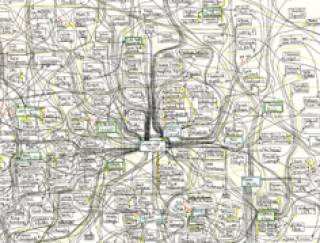Mapping Psychoanalysis
8 September 2015
Ernst Falzeder traces the rise and crisis of psychoanalysis.

Then, from about 1907 onwards, there comes a rapid succession of events that makes the “movement” international and critically changes its structure. The staff of the psychiatric university hospital in Zurich, the Burghölzli, headed by director Eugen Bleuler and chief physician C.G. Jung, publicly support analysis, much to the chagrin of their German colleagues. Mainly through their mediation, others soon join: Sándor Ferenczi from Budapest, Ernest Jones from London (and then Toronto), Karl Abraham and Max Eitingon move from Zurich to Berlin, Abraham A. Brill and James Jackson Putnam from the US. Freud’s and Jung’s lectures there in 1909 further boost interest. After a first informal meeting in 1908, the International Psycho-Analytical Association (IPA) is founded. The analysts also establish their own journals (four in four years) and, in 1918/19, even their own press. In 1920, the Berlin polyclinic and institute is established, offering, for the first time, a standardized training and diploma. In 1925, a so-called training analysis becomes a mandatory requisite for future analysts.
If we take (a bit arbitrarily) the publication of The Interpretation of Dreams (1900) as the birth of psychoanalysis proper, it was only some ten years later that the IPA was founded, and only twenty years later that the first training institute was established, whose structure of formation (training analysis, seminars, and supervision) became the model followed by the rapidly growing number of such institutes around the world. Within only two decades, the psychoanalysts had developed a teaching, training, and accreditation system that functioned more or less independently of Freud. The numbers, too, grew rapidly, from about 200 active IPA members in 1920, to around 12,000 today, not counting the large number of analysts organised in non-IPA groups. The movement originated in Freud’s Vienna, of course, but soon became international, with early centres in Europe and also North America, and then spread to other parts of the world. Forced to emigrate by the rise of Nazism, most Central Europeans moved to English speaking countries, above all the United States and England, and a considerable number also to South America. To this day, the European analysts feel the after-effects of that brain drain.
There are some factors that are peculiar to that development, and distinguish it from that of comparable trends. Firstly, with only very few exceptions, the theoretical and practical formation took place outside academia. Psychoanalysts were organised in their own international association, with local branches, that offered training in their own centres and according to their own self-imposed rules. Secondly, the psychoanalysts published to a great extent in their own journals and even publishing houses, and not in the usual professional journals. Thirdly, through the training analysis, the transfer of knowledge was linked to a profoundly personal experience in a one-on-one setting. A network of “filiations” was thus established, in which every psychoanalyst, to this day, can trace their heritage back to Freud and a handful of un-analysed pioneers (see image). Fourthly, from the beginning, the movement was marked by extremely controversial discussions about the theory and practice of analysis, as well as the requirements for future analysts (must they be MDs?) and their teachers (“training analysts”). This led to various splits (e.g., with Adler, Stekel, Jung, Eugen Bleuler, or Rank), resulting in new “schools”, but also to “local orthodoxies”, which were more or less tolerated within the umbrella association, however (e.g., Sándor Ferenczi, Melanie Klein, Franz Alexander, Sándor Radó, Wilfred Bion, Heinz Kohut …).
In the course of this development, psychoanalysis has undergone considerable changes, and has come a long way from Freud’s claim for exclusivity in 1914: “no one can know better than I do what psycho-analysis is”, to a plurality of theories and practices that, to put it provocatively, are essentially only united by their shared axiom of the “unconscious” and their goal to make it conscious, which led the then president of the IPA, Robert Wallerstein, ask in 1988 if there is not one psychoanalysis, but many.
Today, I think it is safe to say that the golden age of psychoanalysis is over. Its scientific basis is challenged, its practice is competing with many shorter and cheaper psychotherapeutic methods, and above all with Big Pharma. Still, it is probably the most sophisticated and elaborate theory of the human mind so far devised, and, as a therapy, a unique kind of experience that has been appreciated by, and changed the lives of, many persons. It remains to be seen how it will survive in a world that is so utterly different from the one in which it originated, and that continues to change so dramatically on a global scale. I hope it will.
- Ernst Falzeder, PhD, is Senior Research Fellow in Clinical, Educational and Health Psychology at UCL. His latest book 'Psychoanalytic Filiations: Mapping the Psychoanalytic Movement' investigates the history of psychoanalysis, with special emphasis on who analysed whom.
 Close
Close

